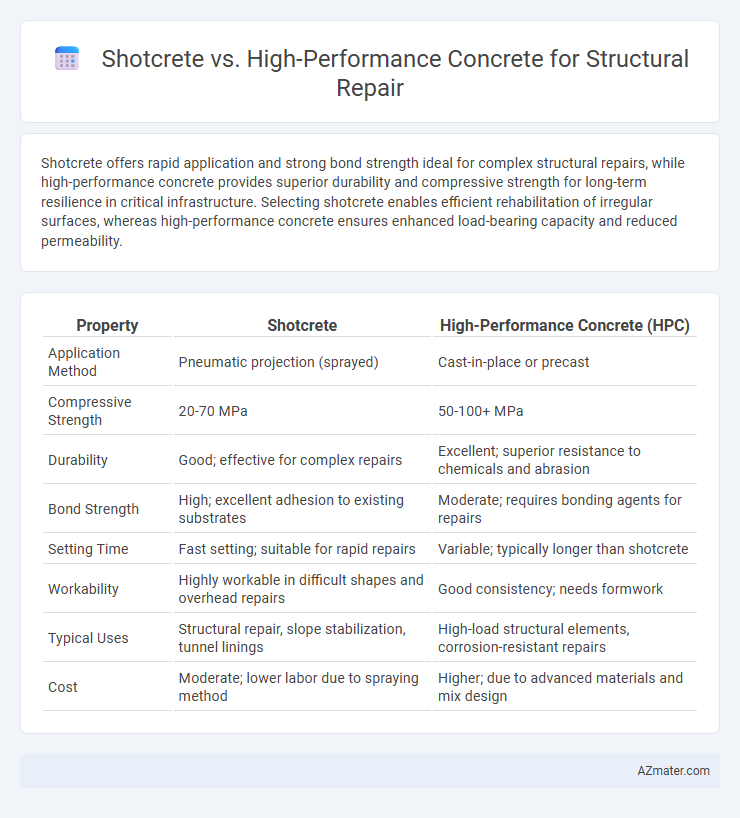Shotcrete offers rapid application and strong bond strength ideal for complex structural repairs, while high-performance concrete provides superior durability and compressive strength for long-term resilience in critical infrastructure. Selecting shotcrete enables efficient rehabilitation of irregular surfaces, whereas high-performance concrete ensures enhanced load-bearing capacity and reduced permeability.
Table of Comparison
| Property | Shotcrete | High-Performance Concrete (HPC) |
|---|---|---|
| Application Method | Pneumatic projection (sprayed) | Cast-in-place or precast |
| Compressive Strength | 20-70 MPa | 50-100+ MPa |
| Durability | Good; effective for complex repairs | Excellent; superior resistance to chemicals and abrasion |
| Bond Strength | High; excellent adhesion to existing substrates | Moderate; requires bonding agents for repairs |
| Setting Time | Fast setting; suitable for rapid repairs | Variable; typically longer than shotcrete |
| Workability | Highly workable in difficult shapes and overhead repairs | Good consistency; needs formwork |
| Typical Uses | Structural repair, slope stabilization, tunnel linings | High-load structural elements, corrosion-resistant repairs |
| Cost | Moderate; lower labor due to spraying method | Higher; due to advanced materials and mix design |
Introduction to Structural Repair Methods
Structural repair methods primarily utilize materials like Shotcrete and High-performance Concrete (HPC) to restore integrity and extend the lifespan of damaged structures. Shotcrete offers rapid application and excellent adhesion, ideal for complex shapes and overhead repairs, while HPC provides superior durability, strength, and resistance to environmental factors. Choosing between Shotcrete and HPC depends on project-specific requirements such as load-bearing capacity, exposure conditions, and repair complexity.
Overview of Shotcrete
Shotcrete, a pneumatically applied concrete mixture, offers rapid application and excellent adhesion for structural repair, making it ideal for complex surfaces and overhead work. Its high compressive strength and durability enhance the longevity of repaired structures, particularly in bridge decks, tunnels, and retaining walls. Compared to traditional methods, shotcrete reduces labor time and material waste while providing superior conformity and bonding strength.
Understanding High-performance Concrete
High-performance concrete (HPC) is engineered to possess superior durability, strength, and workability compared to conventional concrete, making it ideal for structural repair applications that demand longevity and resilience. Its optimized mixture includes supplementary cementitious materials like silica fume, fly ash, and slag, which enhance its mechanical properties and reduce permeability, thereby improving resistance to environmental degradation. HPC's advanced formulation allows for exceptional bond strength and reduced shrinkage, ensuring reliable performance in repairing critical infrastructure components.
Key Material Properties Compared
Shotcrete offers superior adaptability for complex shapes and quick application, exhibiting high compressive strength and excellent bond characteristics essential for effective structural repair. High-performance concrete (HPC) emphasizes enhanced durability, reduced permeability, and improved mechanical properties such as tensile strength and modulus of elasticity, making it ideal for long-term structural integrity. Both materials exhibit specific advantages in mechanical performance, with shotcrete excelling in rapid placement and adhesion while HPC provides enhanced resistance to environmental degradation and sustained load-bearing capacity.
Application Techniques: Shotcrete vs High-performance Concrete
Shotcrete application involves pneumatically projecting concrete onto surfaces, allowing precise placement in complex geometries and overhead repairs, ideal for rapid setting and adherence in structural rehabilitation. High-performance concrete requires conventional formwork and casting, emphasizing controlled curing and mix design for enhanced durability and strength in structural repairs. Choosing between shotcrete and high-performance concrete depends on project-specific factors such as accessibility, structural complexity, and desired performance outcomes.
Durability and Longevity Factors
Shotcrete offers excellent adhesion and rapid application, making it highly effective for structural repair in areas with complex geometries. High-performance concrete, characterized by low permeability, high compressive strength, and improved resistance to chemical attacks, significantly enhances durability and longevity in structural elements. Both materials contribute to extending service life, but high-performance concrete often outperforms shotcrete in long-term durability due to superior mix design and densification characteristics.
Cost Implications and Budget Considerations
Shotcrete offers a cost-effective solution for structural repair due to lower material and labor expenses compared to high-performance concrete, which involves higher-quality ingredients and precise mixing techniques increasing overall investment. Budget considerations must account for shotcrete's faster application and reduced formwork requirements, leading to savings on project timelines, whereas high-performance concrete demands extended curing periods and specialized skills, raising labor costs. Evaluating long-term durability and lifecycle costs reveals high-performance concrete may reduce maintenance expenses, balancing initial higher costs against potential future savings in structural repair projects.
Suitability for Different Repair Scenarios
Shotcrete offers excellent adaptability for complex geometries and overhead repairs, making it suitable for intricate patching and localized structural rehabilitation. High-performance concrete (HPC) excels in large-scale structural repairs requiring enhanced durability, high compressive strength, and resistance to harsh environmental conditions. Selecting between shotcrete and HPC depends on the repair scope, with shotcrete favored for rapid application and HPC preferred for long-term durability in demanding environments.
Environmental and Sustainability Aspects
Shotcrete offers sustainable advantages through reduced material waste and lower transportation emissions due to on-site mixing, enhancing its environmental profile for structural repair. High-performance concrete (HPC) features optimized mix designs with supplementary cementitious materials like fly ash or slag, reducing cement content and carbon footprint while improving durability and lifespan. Both materials contribute to sustainability by extending structure service life, but HPC typically provides superior long-term environmental benefits through enhanced strength and reduced maintenance needs.
Choosing the Right Method for Your Project
Selecting between shotcrete and high-performance concrete for structural repair depends on factors such as project complexity, repair thickness, and environmental conditions. Shotcrete offers superior adhesion and faster application for overhead and vertical surfaces, making it ideal for complex shapes and localized repairs. High-performance concrete provides enhanced durability and strength for large-scale repairs requiring longer service life under heavy loads or aggressive exposure.

Infographic: Shotcrete vs High-performance Concrete for Structural Repair
 azmater.com
azmater.com